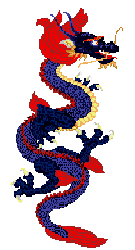
Well
now we are going to explore another part of Japan that I find
interesting, the Japanese Gods of myth. So lets get started ^_^
 Aizen-Myoo
(Aizen Myo'o)
Aizen-Myoo
(Aizen Myo'o)
The Japanese
god of love, worshipped by
prostitutes, landlords, singers and musicians. Despite
his ferocious appearance (he has a third eye
vertically placed between his two other eyes and a
lion's head in his hair) he is considered to be
beneficent to mankind. Originally he was a god of
the Shingon and Tendia and represented love that
changes into desiring 'enlightenment'.
Ajari
Joan
A Japanese
priest from the mountain Hakkotsu-San
("Skeleton Mountain"). The priest once loved a girl,
which is a sin for Buddhist priests. He became an
okuma, a devil, and destroyed his own temple. As
an old man he recovered his wits and sat down to
pray. He went on muttering prayers after he died,
becoming a praying skeleton.
Aji-Suki-Taka-Hi-Kone
The
Japanese god of thunder, one of several. He
was born noisy, and when grew up he became even
more noisier. To quiet him, the gods carried him up
and down a ladder (this explains the approaching
and receding sound of thunder).
Am-No-Tanabata-Hime
(Am-No-Tanabata-Hime-No-Mikoto)
The
Japanese astral goddess of weavers.
Ama-Tsu-Mara
The
Japanese Shinto god of smiths. Together with
Ishi-Kori-dome this cyclopean blacksmith god made
the solar mirror which was used in enticing
Amaterasu out of the cave in which she had been
hiding.
Amaterasu
(Ama Terasu)
The
Japanese Shinto sun goddess, ruler of the
Plain of Heaven, whose name means 'shining
heaven' or 'she who shines in the heavens'. She is
the central figure in the Shinto pantheon and the
Japanese Imperial family claims descent from her
1. She is the eldest daughter of Izanagi. She was
so bright and radiant that her parents sent her up
the Celestial Ladder to heaven, where she has
ruled ever since.
Ame-No-Mi-Kumari (Ame-No-Mi-Kumari-no-Kami)
A Japanese Shinto water goddess.
Anshitsu
A Japanese hermitage for a solitary Buddhist monk.
The lonely traveler should be wary of asking for
shelter there at night, for it may happen that the
gloomy figure who opens the door is only the ghost
of the monk who once lived there.
Awabi
Japanese sea demons who live near Nanao. They
eat fishermen when they drown and are the
guardians of large seashells containing shining jewels.
Baku
A Japanese good spirit, called the 'eater of dreams'.
It is said that evil dreams are caused by evil spirits.
When a person awakens from a nightmare, he may
call upon Baku, saying: "Baku, eat my dreams."
Thus Baku may be induced to turn a bad dream into
good fortune by eating up the evil. The creature has
a lion's head, tiger's feet and a horse's body.
Benten (Benzai-ten, Benzai-tennyo)
The Japanese goddess of love, eloquence, wisdom,
the arts, music, knowledge, good fortune and water.
She is the patroness of geishas, dancers, and
musicians. Originally she was a sea goddess or
water goddess, on whose image many local deities
near lakes were based. Later she became a goddess
of the rich and was added to the Shichi Fukujin. The
island of Enoshima rose up especially to receive her
footsteps.
Centipede
A terrifying, man-eating monster the size of a
mountain. It lived in the mountains of Japan near
Lake Biwa. The dragon king of that particular lake
asked the famous hero Hidesato to kill it for him.
The hero slew it by shooting an arrow, dipped in his
own saliva, into the brain of the monster. The dragon
king rewarded Hidesato by giving him a rice-bag; a
bag of rice which could not be emptied and it fed his
family for centuries.
Ebisu
The Japanese god who represents the wealth of the
sea, and patron of all that is related to fishing,
especially fishermen. Also the god of labor. He is
sometimes mentioned as the son of Daikoku, who
represents the wealth of the earth. Ebisu was
worshipped in the coastal region near Osaka (where
his temple was located) and was portrayed with a
fish and a fishing rod. He is one of the seven Shichi
Fukujin. Anything found on the beach may be Ebisu,
even a ghost or its corpse.
Emma-o (Emma-ten)
The Japanese Buddhist god of the underworld (from
the Sanskrit Yama). He lives in the Yellow Springs
under the earth in a huge castle all covered in silver
and gold, rosy pearls and other jewels. He is the
judge of the dead and notes the sins of those who
are sentenced to purgatory, and decides the degree
of their punishments according to Buddha's Law.
Anyone who has killed an innocent will be thrown
into a boiling cauldron full of molten metal.
However, if they have made a pilgrimage to each of
the 33 shrines of the goddess of mercy Kannon,
then all the evil they have done will disappear.
Sometimes he is portrayed less pitiless and returns
life to those who appear before him.
On the last day of the Festival of the Dead, the
sea
is full of shoryobuni ('soul ships'), for on that day
the high tide brings a flood of returning ghost who go
back to their spirit world. The sea is luminescent
with the light these souls emit, and their whispering
can be heard. While the ghosts are embarking, no
human ship should come near. Should one stray into
the soul-covered sea, the ghosts will ask for pails.
The sailors should only offer them pails without
bottoms, for if they do not, the ghosts will sink their
ship. Currently, Emma-o is used as a bogeyman to
scare little children.

Home |

Forward |
music by Akina Nakamori"


 Aizen-Myoo
(Aizen Myo'o)
Aizen-Myoo
(Aizen Myo'o)